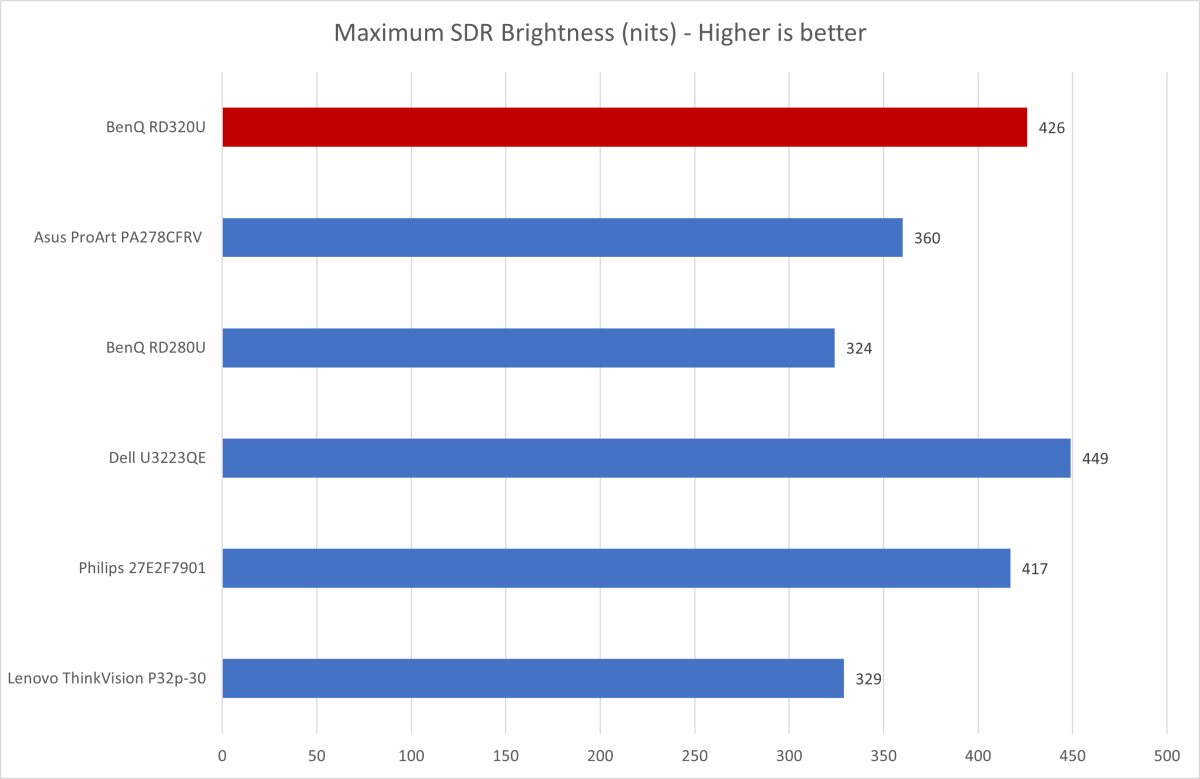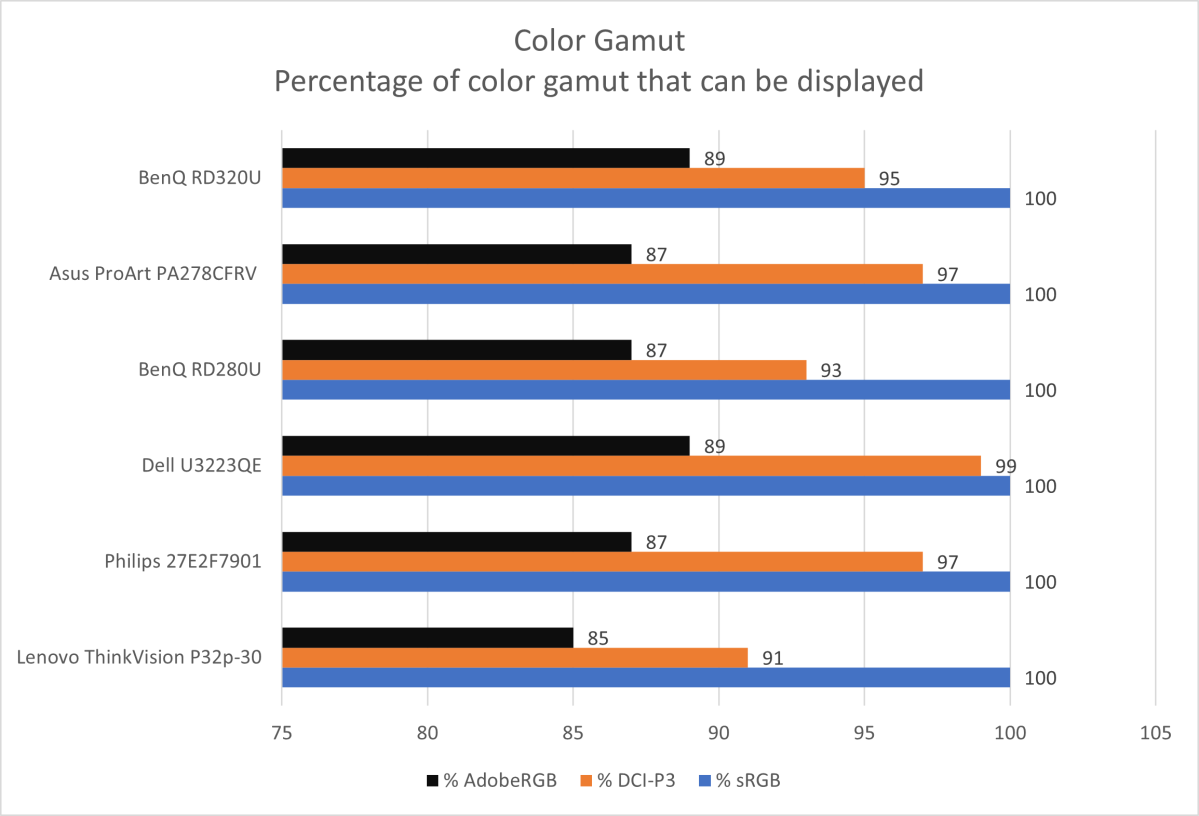BenQ RD320U review: This is the 4K display programmers crave

 Image: Matthew Smith / Foundry
Image: Matthew Smith / FoundryAt a glance
Expert’s Rating
Pros
Useful “MoonHalo” ambient light, plus ambient light sensor Lots of USB connectivity Tack-sharp 32-inch 4K display Excellent color performance
Cons
USB hub lacks features of some competitors, like Thunderbolt or Ethernet Meager HDR performance Only a 75Hz refresh rate, no Adaptive Sync
Our Verdict
The BenQ RD320U is a great choice for programmers and can also prove itself useful as a do-it-all home office monitor.
Price When Reviewed
This value will show the geolocated pricing text for product undefined
Best Pricing Today
Best Prices Today: BenQ RD320U
RetailerPrice
Do you need a monitor for programming?
Technically, almost any monitor can work and, because of this, monitor makers often fail to market their displays specifically to programmers. However, BenQ is addressing this gap with its latest line of programming monitors. We’ve previously reviewed the BenQ RD280U, which is notable for its distinctive 3:2 aspect ratio. However, the company also offers the more traditional RD320U, a 32-inch 16:9 4K display packed with features tailored to meet the needs of programmers.
BenQ RD320U specs and features
At its core, the BenQ RD320U is a solid 32-inch 4K display. It has an IPS Black panel (which should improve the contrast ratio) and delivers a sharp image at 3840×2160 resolution.
Display size: 32-inch 16:9 widescreen Native resolution: 3840×2160 Panel type: IPS Black Refresh rate: Up to 75Hz Adaptive sync: None HDR: Yes, VESA DisplayHDR 400 Certified Ports: 2x HDMI 2.0, 1x DisplayPort 1.4, 1x USB-C with 90 watts of Power Delivery and DisplayPort Alternate Mode, 1x USB-B 3.2 Gen 1 upstream, 2x USB-A 3.2 Gen 2 downstream, 2x USB-C 3.2 Gen 2 downstream, 3.5mm audio-out VESA mount: 100x100mm Speakers: 2x 3-watt speakers Price: $649.99 MSRP
It’s also jam-packed with ports, including a USB-C port with DisplayPort and USB Power Delivery. Though pitched to programmers, the RD320U’s specifications make it a competitor to high-end home office monitors like the Dell Ultrasharp U3223QE and Philips Creator Series 27E2F7901.
Further reading: Best home office monitors
BenQ RD320U design
At a glance, the BenQ RD320U’s design is basic. It’s clad in various shades of charcoal black that don’t immediately catch your eye. Take a second look, though, and you’ll notice the details, like the rippled pattern that cascades down the rear of the monitor and the lower display bezel. These add a subtle bit of flair that makes the monitor distinct from its competition.
The star of the show, however, is in fact a moon — or MoonHalo, as BenQ calls it. The MoonHalo is a ring of LED lights centered on the rear of the monitor. It’s like the RGB-LED lights on gaming monitors, but instead meant to provide soft, consistent ambient light. The MoonHalo is always white, but you can adjust the color temperature to match the display. I enjoyed the MoonHalo; it looks nice and I felt it made the display less tiring to view after dark.

The “MoonHalo” on the back of the BenQ RD320U.
Matthew Smith / Foundry
The monitor ships with an ergonomic stand that adjusts for height, tilt, pivot, and swivel. The stand is attached to a mid-sized, flat base. It’s a bit wider than it needs to be, but since it’s flat, the desk space it occupies remains usable. I’m not a fan of the stand’s cable management, however. The faux-leather strap BenQ provides for the purpose is attractive but can’t hold many cables.
While the included stand is nice, BenQ also provides a 100x100mm VESA mount for use with third-party monitor arms and stands.
BenQ RD320U connectivity and menus
The BenQ RD320U has four video inputs: two HDMI, one DisplayPort, and one USB-C with DisplayPort. To be honest, I’d rather it had two DisplayPort ports than two HDMI, but that’s a nitpick. This is a solid range of video connectivity.
In addition to DisplayPort, the USB-C port also provides up to 90 watts of USB Power Delivery and supports data for connections to multiple downstream USB-A and USB-C ports. Two USB-A ports, and one USB-C port, are located on the monitor’s chin, which makes them easy to access. A KVM switch function is included, too.
A USB-B upstream port provides an alternative way to connect to the monitor’s USB hub, which is useful if your PC lacks USB-C.
The BenQ RD320U’s USB connectivity isn’t as extensive as the Dell Ultrasharp U3223QE, which has more USB ports and provides Ethernet, so those looking for a USB hub should give Dell’s alternative a look. Still, the BenQ’s connectivity is a hair above average, as it delivers several downstream USB ports and places them in convenient locations.

The BenQ RD320U’s on-screen menu.
Matthew Smith / Foundry
BenQ’s on-screen menus are accessed with a quick, responsive joystick centered on the monitor’s chin. The menu is large, which makes it easier to see and read (though, unfortunately, the menu’s font is still a bit thin). I also found the menus logically arranged and had no issues finding the settings I want. BenQ, like most of its competitors, also provides a Windows software utility (Display Pilot 2) to access and control monitor settings.
The BenQ RD320U’s image quality options are a bit underwhelming. It uses vague presets for gamma and color temperature instead of providing the proper, numerical labels. An sRGB color gamut preset is available, but no preset is available for DCI-P3 or AdobeRGB. I understand this isn’t a “creator” monitor, but its performance is certainly good enough to make these presets useful.
Programmers won’t mind, however, because the RD320U offers several features that come in handy while coding. This includes two preset “Coding Booster” modes that adjust brightness, contrast, and gamma to make code easy to read.
The monitor also has an ambient light sensor that can automatically adjust the monitor’s brightness throughout the day. The ambient light sensor is pitched to programmers as a way to reduce eye strain, but the feature is just as useful for writers, creators, accountants, and anyone else who spends a lot of time in front of a monitor.
Speakers are included, but they’re not great. The pair of bundled 3-watt speakers produce sound with reasonable clarity at low volumes but quickly become overwhelmed as volume is increased. They’re fine for listening to a podcast or playing soft, ambient tones, but speakers or headphones will be necessary for true audio enjoyment.
The BenQ RD320U includes two preset ‘Coding Booster’ modes that adjust brightness, contrast, and gamma to make code easy to read.
BenQ RD320U SDR image quality
The BenQ RD320U is a great example of a monitor that doesn’t necessarily need great image quality to satisfy its intended user. Programmers are staring at code, right? Fortunately, BenQ doesn’t use that as an excuse to deliver half-baked SDR image quality. On the contrary, the BenQ RD320U looks great.

Matthew Smith / Foundry
BenQ gets off to a great start in brightness, as the RD320U delivers an excellent 426 nits of peak SDR luminance. That’s a lot, and certainly far more than most programmers will need.
Still, a high level of SDR brightness means the monitor remains usable in a brightly lit room. That’s good news if your office has sunlit windows or you’re coding in a bullpen that looks straight out of The Wolf of Wall Street.

Matthew Smith / Foundry
There’s more good news in contrast, as the BenQ RD320U comes close to delivering a contrast ratio of 2000:1. BenQ doesn’t market the monitor as having an “IPS Black” display panel, but this is a level of contrast I’ve only witnessed in IPS panels of that type. It keeps the RD320U competitive with class leaders like the Dell U3223QE and Philips 27E2F7901.
The comparison with BenQ’s RD280U is notable, as well. BenQ’s smaller programming monitor clearly has a different IPS panel that doesn’t match the RD320U in contrast.
While the BenQ RD320U’s contrast is great for its category, shoppers should remember that OLED displays can achieve an effectively infinite contrast ratio, which makes them a better choice for games, movies, and other entertainment.

Matthew Smith / Foundry
I was worried the BenQ RD320U might neglect the color gamut and limit itself to a narrower range, but that’s not the case. It covers up to 95 percent of the DCI-P3 gamut and up to 89 percent of DCI-P3. The RD320U looks vibrant and alluring when displaying photos, videos, and games.
With that said, however, the RD320U falls behind the Dell U3223QE and Philips 27E2F7901 in coverage of the DCI-P3 color gamut. So, while the RD320U does well enough, it’s not the best choice for content creators who care about DCI-P3.

Matthew Smith / Foundry
I was even more surprised by the BenQ RD320U’s color accuracy, which absolutely bakes. Or cooks? What are the kids saying, these days?
Either way, it’s good. Extremely good. Top-5-PCWorld-has-ever-tested good. It’s a bit of a surprise, and I suspect there’s a little bit of random variance at play here; I likely lucked out with an especially good example of the RD320U. Still, BenQ has a history of good color accuracy, and it’s excellent to see the RD320U score well here. Though meant for programming, the RD320U can serve as an entry-level monitor for digital artists and photographers.
The gamma and color temperature tests reported more good news, as the BenQ RD320U hit our target gamma of 2.2 and color temperature of 6500K. Most monitors come close to these targets, but it’s nice to see the RD320U hit both dead-on. This means the monitor does not look overly bright or dark, nor too cool or warm.
With that said, the ideal gamma and color temperature can vary depending on your needs and personal preference. The monitor has options to adjust both — though, as mentioned previously, they’re not well-labeled.
Sharpness is yet another perk. The 32-inch 3840×2160 panel provides a sharpness of 138 pixels per inch (PPI). It’s not quite as sharp as a 27-inch 4K display, which hits 163 PPI, but it’s noticeably superior to any 1440p monitor. This is helpful for programmers, as it helps the monitor display small fonts with a crisp, tack-sharp look.
The BenQ RD320U scores high marks in SDR image quality. It scores well across every metric and has no significant weakness that might place it behind the competition. Alternatives like the Dell U3223QE can match the RD320U, but older monitors like the ThinkVision P32p-32 can’t keep up.
BenQ RD320U HDR image quality
The BenQ RD320U supports HDR and has VESA DisplayHDR 400 certification, but it’s not a good pick for HDR movies and games.
Contrast and luminance are issues. While the monitor can peak above 400 nits, that’s not enough to deliver the full oomph of HDR, as most HDR content targets a peak brightness of at least 1,000 nits.
The monitor also lacks a dynamic backlight, which means the monitor’s contrast isn’t comparable to Mini-LED or OLED displays. Placed next to such alternatives, the BenQ RD320U’s HDR image will look flat and washed-out.
This, to be fair, is a typical problem for all mid-range IPS monitors. A productivity and programming display like the BenQ RD320U might support HDR, but it’s not the focus, as nearly all productivity software is designed for SDR. Still, buyers should be aware: This is not the monitor for HDR.
BenQ RD320U motion performance
It’s not the monitor for motion clarity, either.
The BenQ RD320U has a maximum refresh rate of up to 75Hz and doesn’t support Adaptive Sync for smooth frame pacing in PC games. Motion clarity is fine for less hectic games, but it’s an obvious step behind a 144Hz monitor.
Of course, programmers spend most of their time looking at relatively static code, so mediocre motion clarity isn’t a huge deal. Still, I suspect many programmers would like to play some PC games in their downtime. The BenQ RD320U isn’t the best choice for that.
Is the BenQ RD320U worth it?
The BenQ RD320U is a solid 32-inch 4K monitor. Though it’s targeted at programmers, and offers several features they’ll appreciate, it has broader appeal as a home office and productivity monitor. It has a bright, crisp image, an ambient sensor to automatically adjust brightness, and packs a useful USB-C hub.
BenQ faces a lot of competition in this space, such as the Dell U3223QE, which has an equally attractive panel and a wider range of connectivity, including Ethernet. I’d still recommend the Dell U3223QE over the RD320U for general productivity, but it’s a close call, and the discounts available at the time you buy could sway the decision either way. If you’re a programmer, though, the RD320U has an advantage.
Best Prices Today: BenQ RD320U
RetailerPrice
Author: Matthew S. Smith
Matthew S. Smith is a freelance technology journalist with 15 years of experience reviewing consumer electronics. In addition to PCWorld, his work can be found on Wired, Ars Technica, Digital Trends, Reviewed, IGN, and Lifewire. Matthew also covers AI and the metaverse for IEEE Spectrum and runs Computer Gaming Yesterday, a YouTube channel devoted to PC gaming history.
Recent stories by Matthew S. Smith:
Best home office monitors 2024: Displays that get the job doneLG MyView Smart Monitor 32SR85U review: A monitor at odds with itselfBest ultrawide monitors 2024: Picks for gaming, budget, 5K, premium, and more






